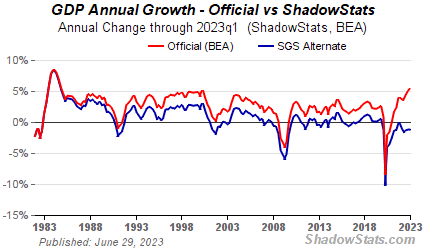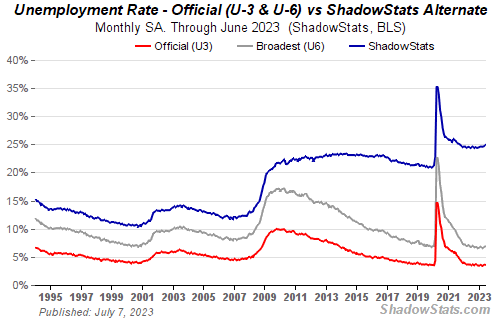
Posted on 12/03/2011 12:24:01 PM PST by neverdem
As the Bureau of Labor Statistics announced a fall in the unemployment rate from 9.0 to 8.6 percent, it noted that a contraction of the labor force accounted for more than half the reduction in the number of unemployed. As the following table shows, this represents the continuation of long-standing trends (December 2007 represents the start of the Great Recession; Barack Obama took office in January 2009; November 2011 is the latest report, out December 2):

Three points are worthy of note.
First: Despite the growth of the working-age population over the past four years, the labor force (roughly, the sum of those employed plus job-seekers) has not expanded. For various reasons, more and more Americans have been dropping out of the labor force. If Americans of working age were participating in the labor force at the same rate as they were at the onset of the recession, the labor force would be nearly 5 million people larger, and unemployment would be significantly worse in both absolute and percentage terms.
Second: Despite the modest economic recovery since the recession ended in mid-2009, total employment remains more than 5.5 million below the level of 2007 and about 1.6 million below where it was when President Obama took office.
Third: To regain full employment (5 percent, which happens to be the same as the level when the recession began) with the pre-recessionary labor force participation rate, we would need 150.7 million jobs—10.1 million more than we have today. That’s a reasonable measure of the hole we’re still in, two and a half years since the official end of the recession.
The American people are unlikely to cheer up about the economy until we get appreciably closer to the top of the hole.
Bill Galston is a senior fellow at the Brookings Institution and a contributing editor for The New Republic.
Since I was raised by leftwing lunatics and taught by Marxist fools, I can tell you what’s going on here.
In order for the revolution to succeed, the middle class needs to be destroyed. The middle class is the core of bourgeois values in a capitalist society, and that class needs to be pushed into the proletariat in order for change to occur - otherwise, the middle class will prevent revolutionary and progressive change to take place.
Which is why our Beloved Leader just recently used the metaphor of the Factory Owner and the Factory Worker in a speech - he’s a committed Marxist. He believes in class division, even if you don’t. You’ll notice that there’s no middle class there. And, as he said so loudly, “change has come to America.”
God help us.
Which means by the job participation rate in 2007/2008 that unemployment today would be 11-12%. I think saying the recession started in 2007 is bogus for 2 reasons: there were not two consecutive quarters of contraction until mid-2008, and unemployment didn't start rising until the same point in time. Realistically speaking the recession didn't start until the third quarter of 2008.


Right! 3rd quarter 2008! And the REAL rate of unemployment is much higher than 8.6% currently and 11-12% may be generously low.
I don't accept being effectively manipulated in this way because of inappropriately applied metrics. NBER (only a private firm, not a deity) clearly ought to reassess their standards for defining a recession because they are inadequate as they stand.




Rob Paul is not my fav for POTUS, but I just saw this today where he destroys Sen. Kanjorski (D) on CNBC RE: Bernanke’s reconfirmation to the Fed here: RON PAUL EMBARRASSES KANJORSKI-CNBC Part I
Notice how the news of the falling unemployment rate was greeted by oil being big up to over $100 a barrel, whereas Bernanke proclaimed earlier this year that he was going to keep the Fed Funds rate at zero percent until the end of 2013.
The problem with jobs is that producer prices are several percentage points higher than the consumer price index rate of inflation and that margin means fewer jobs as producers cannot pass along the full Bernanke inflation.
Last I heard, the CPI was about 4% but the Fed Funds rate was zero—which seems suicidally inflationary.....but Bernanke has locked himself in because if he breaks his promise and raises interest rates early, he explodes the gold bubble, the oil bubble, the stuck bubble and bond bubble-—so expect gas prices to skyrocket again and choke off the recovery.
I think Republicans should just argue to ELIMINATE the individual side of the Social Security tax and go back to the Reagan tax code otherwise and raise the gas tax and index it for inflation. Make the SS tax cut permanent because the middle class and small business overpaid Social Security for 30 years , and that’s what created the “trust fund”. Give back the trust fund through a tax cut, by eliminating the individual side of the SS tax.
Also-—you bring back Clinton’s 39.8% rate on taxable income over $1 million dollars-—thus you have a tax code with no SS tax on the individual side, then 15% , then 28%-—then 39.8% only on income over $1 million. That’s just political reality.
The top tax rate now is 35%, but you also have a 33% rate.....and the 35% kicks in at $360,000. It wouldn’t hurt at all—especially if you eliminate the SS tax———to eliminate the 33% rate and just go from 28% to 39.8% on the highest incomes..
But the corporate income tax should be cut, too, to 28%-———and there should be a tax deduction for dividends. Cap gains would go to 28%, but you exempt the first $15,000 and index for inflation-—and more at retirement.
Maybe you let employers put more money into employee 401k plans to build them again——and give them a tax credit for routing profits to employee retirement plans.....
We want fast growth while Bernanke’s got interest rates so low——and this kind of tax cut takes some burden off of employers paying higher prices......
But really-—the Fed’s “dual mandate” needs to be amended. The Fed NEVER should have the power to have interest rates below the producer and consumer rates of inflation, not too far above those rates.
When Reagan became president, the top tax rate was 70% on just $55k taxable income...ie it was atrociously high and steep. That’s what the Laffer Curve was about.
But the economy grew well after 1982 thru 1986—when the top tax rate was 50% and the gas tax was higher , too.
In 1987, the top tax rate fell to 38%, then in 1988
—ie Reagan’s last year-——the top tax rate fell to 28% and the capital gains tax rose to 28%-—at just $18,500 taxable income.
There ARE political realities. The economy grew fast for 4 years under Reagan when the top tax rate was 50% on less than $100k taxable income-—so obviously, it can grow at a top rate of 39.8% on over $1million taxable income, with a lower corporate income tax rate, no double taxation of dividends, and no individual SS tax.......
Just thinkin”
We need to WIN this election and cut spending and save the world for property rights and profits and capitalism.
Having 3 tax rates: 15%, 28%, and 39.8% on millionares only———is better than what Reagan had for most of his 8 years———and is better than what Clinton had, too—because it has NO Social Security tax on the individual side. lower corporate tax and dividend tax, etc.......
Too many folks are reading Atlas Shrugged.
This, even though Galston is obviously right.
Galston, a Clintonista, is usually worth a gander. His essays appear to be honest, IMHO.
There were many more deductions back then and the alternative minimum tax didn’t kick in like it does now. You talk about top rates of 70% but nobody paid them as there were endless deductions and tax shelters. Much has changed since then. There’s only one way to get more revenue and that’s increase the tax base. And to do that you have lower the threshold of income that people have to pay taxes at. Too many get a free ride while immorally getting to vote to tax somebody else.
Disclaimer: Opinions posted on Free Republic are those of the individual posters and do not necessarily represent the opinion of Free Republic or its management. All materials posted herein are protected by copyright law and the exemption for fair use of copyrighted works.